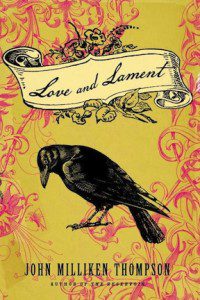
If memory, as Eudora Welty wrote, “is a living thing [and] all that is remembered joins, and lives—the old and the young, the past and the present, the living and the dead”, then John Milliken Thompson’s novel Love and Lament is a monument to memory in its most powerful comingling of past and present. This is an ambitious and engrossing book, difficult to put down and, at times, almost too painful to contemplate. Mary Bet Hartsoe is the youngest of nine children; she is born twenty-two years after the Civil War but is surrounded by Confederate veterans and those who hold in recent memory the pioneer generations that settled North Carolina. We follow her as she grows up and establishes a home in Haw County, never leaving the extended community that Thompson skillfully depicts, during that tumultuous period in American history from the end of Reconstruction through World War I.
The world of Haw County is richly fashioned, and immersing oneself in its history and families is one of the great pleasures of this novel. Thompson creates a narrative that projects an over-arching view of the interconnected relationships that frame the story, while also weaving in granular details that enhance it in a beautiful way: an old widower’s hint of an Irish accent, a worn blue Union jacket folded among some moonshiners’ belongings, the poems of Keats and Wordsworth read to a dying young woman. This juxtaposition of generations of history with ephemeral observations is artful on its own, but it also heightens the profound sense of tragedy that permeates Mary Bet’s life. By the time she is ten, Mary Bet has lost most of her family; by the time she is a young woman, she seems equal parts dismayed, embarrassed, and astounded at herself “just for living so long”. The deaths of her family members are so rapid, so inexplicable, so numerous that we grieve right alongside Mary Bet, even early on in the novel, and even though her grief is relatively clear-eyed. When her twin siblings Willie and Annie died of typhoid, I found their deaths as sad and as terrible as those that came many years and pages later; in just a sliver of the novel, Thompson created two characters too memorable not to mourn. And throughout the course of reading the book—which is nearly 400 pages—I found myself continuing to marvel at how many family members were gone, and how different both Haw County and Mary Bet’s life would have been had they lived.
This is not to suggest that Love and Lament is lacking with regard to characters or plot, but that the temptation to consider how life might have unfolded otherwise for the Hartsoes never leaves. I would argue that it even strengthens the novel by making Mary Bet a more complex and intriguing protagonist, and Cicero, her father, compelling despite his inescapable flaws. Thompson’s gift for voice must be acknowledged as well; he writes convincingly from both Mary Bet’s and Cicero’s perspectives, across a range of ages. This talent extends to other characters, too, both in terms of general depiction—an elderly black man trying to register to vote is one such powerful sketch—and in terms of conveying their thoughts and insights, as he does with Mary Bet’s friend Leon when Leon realizes he wants to become a teacher. And again, the small details with which he imbues individual characters are seamlessly and wonderfully integrated, from Aunt Cattie Jordan, who relishes a good meal, “working on a biscuit thick with jam”, to Mary Bet’s sister Myrtle Emma, who “could play the piano as if she were playing a harp”.

Throughout the book, much is made of curses and the power and existence of God versus those of the devil, and under the auspices of this general theme two Presbyterian circuit preachers do play intriguing bit parts. I found myself struck more, however, by the ways in which Thompson communicates the omnipresence of death at the turn of the twentieth century, and the general rumination it sparked among the characters, than I did by Mary Bet’s or anyone else’s religious fears. Not only are many of the illnesses and mishaps that prove fatal to those in the book relatively non-threatening today, but also the general violence the characters experience throughout the novel’s thirty years is hard to fathom. Cicero wears a wooden leg, a visible reminder of the Civil War, but smaller details also underscore differences between then and now—when President McKinley dies, Cicero notes that McKinley is the third president assassinated in his lifetime. The characters’ ceaseless intimacy with death is one reason why reading a time-displaced novel like Love and Lament can be so powerful. Universal milestones mark Mary Bet’s life—she comes of age, she loses her parents, she falls in love—but her story is captivating because of the tension between these familiar experiences and the remote context and circumstances of her era. To the great benefit of those who read this book, Thompson teases out this tension to shape and inform Mary Bet, the characters that surround her, and the community of Haw County.
At times the novel can seem too ambitious; for example, Thompson continues to introduce some new, fairly substantive characters right up towards the end of the novel, and few added much to the story. The section on World War I seems a bit like it was shoehorned into the book (but I still wanted to read about Leon’s experience in the war, and enjoyed doing so). I also wish Thompson had further fleshed out the trajectory of Siler, one of Mary Bet’s brothers—the relationship between Siler and Cicero could have been more fully addressed—and I would have liked to know more about Mary Bet’s brother Tom, her mother, and her mother’s siblings. Her cousin Hooper’s storyline seems to fizzle out for no reason. Some minor plot twists late in the book seemed incongruous with the rest of the narrative arc, and for a few pages, Thompson jarringly and inexplicably identifies Mary Bet by her job title rather than by her name.
Even when Thompson appears to be overreaching, however, Love and Lament is still strong. And in some ways, the overreaching feels appropriate. Through new characters and new settings, there is the sense that life keeps moving forward for Mary Bet—a woman who grew up convinced her life would end soon, as it did for many of those she loved. Thompson evokes the rich life that Mary Bet ultimately develops right before the novel concludes, in a scene in which Mary Bet is surrounded by many friends and individuals who love and respect her. The absence of so many of her family members is keenly felt, but the presence of these people is equally powerful. “All that is remembered joins, and lives”, wrote Welty. Thompson, who seems to be a natural heir to that great Southern writer, has written a wonderful book that testifies to that truth.




